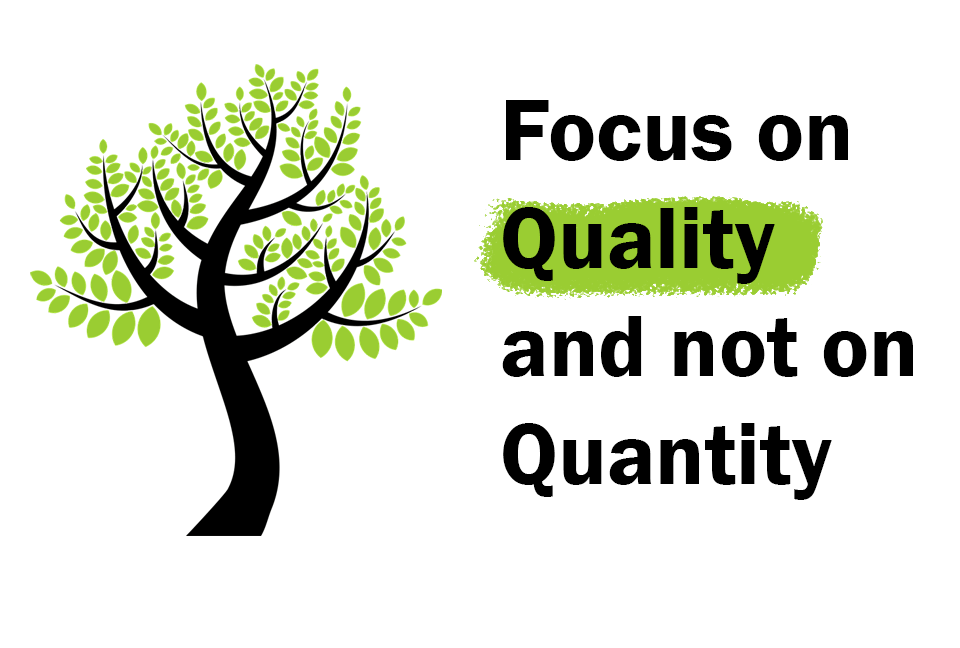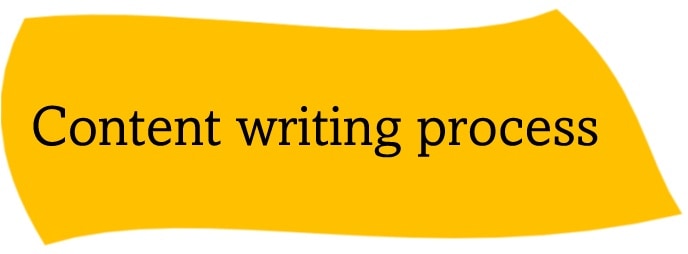One of the biggest problems faced by people wanting to use content marketing as their main marketing tool, is writing and producing original content.
Original content in itself doesn’t help you much unless it really resonates with your audience – audience that will eventually do business with you.
So, for successful content marketing, you need original content, and also relevant content.
For the sake of brevity, in this blog post when I talk about writing original content, I also mean writing relevant content (this goes without saying, but I’m saying it anyway).
Writing and publishing original content shouldn’t seem like a big challenge. You just need to have a strong desire to communicate to your visitors.
For this, you really need to know what you want to talk about.
Have a clearly-defined objective for your content marketing
This is one of the best ways of writing original content. If you have a clearly-defined objective for your content marketing, every piece of content has a meaning.
What do you want to achieve with your content marketing?
Of course, you’re going to say that you want to grow your business. You want to attract more customers and clients.
That is the end result.
Customers and clients don’t come to you just because you are open for business.
Rains don’t come because they have to water your farms. They come when the clouds reach a region where the temperature is lower and clouds can turn into water.
Many factors collectively work to bring people to your business, make them trust you and then make them become your paying customers and clients.
Content marketing is for these factors. People becoming your customers and clients is just a by-product of these factors coming together to act together.
For companies like Amazon and Apple, it is loyalty and brand presence. People want to buy an iPhone because they want to associate with the brand (aside from the fact that iPhones are awesome).
Recently I purchased a OnePlus mobile phone because one, my sister-in-law is a travel blogger and she has been quite happy with the pictures that she clicks with her OnePlus. And two, the company has built a community around its brand, just the way Apple has been able to.
I needed a mobile phone with a good camera, and many people vouch for its camera on YouTube and various blogs.
I haven’t bought their phone just because they have a phone or even because they have a quality phone (many mobile phone companies have quality phones); I have bought because directly or indirectly, so many people have told me that buying their mobile phone is a good deal. I’ve discovered, it actually is, but that’s another story.
Through their content marketing, OnePlus has attracted people who are looking for a mobile phone with more than average-quality camera. Of course, they’re not lying, the camera is actually good, but then again, as I said, there are many mobile phones with equally good cameras.
The difference is, the company has seeded lots of content that primarily focuses on its good quality camera. This is the audience they have been drawing to their brand.
Interestingly, when I went to buy the phone from a local electronics showroom, the sales man very forcibly tried to sell me an LG mobile phone which, he claimed, has a better camera and in fact, at that moment, it did look to be better than the OnePlus model that I had gone to purchase, but I had read nothing about the LG model. In fact, I rarely come across blog posts and YouTube videos on LG Mobile phones, so, I had no information. At one point, I got so exasperated that I told the salesman that I was going to go back without buying any phone, only then he backed down.
You can find numerous blog posts and YouTube videos where people compare the OnePlus camera with the camera of Google Pixel, iPhone, and many other phones, and then conclude that the OnePlus camera is the best.
So, maybe that was their objective.
For writing original content, it is very important to have a well-defined objective for your content marketing. The moment you have an objective, you can have a long list of topics you want to cover whether you want to write blog posts or create videos.
Provide solutions to problems people actually face, for original content writing
Whenever people access your content, make sure that they learn something that they cannot learn somewhere else.
Of course, the Internet brims with quality content but when you try to solve the problem according to your point of view, you introduce a unique perspective. Your unique perspective will be hard to find on other websites and platforms.
Developing your own style also helps. Even if the topics that you are covering have been covered by pretty much everyone, you can always write about topics in your own unique style.
Maybe you are humorous. Cynical. Sarcastic. Scholarly.
Never think that a particular writing style is unacceptable (I’m not suggesting you hurt people’s feelings). But definitely develop your own style.
Focus on quality and not quantity
Publishing a well-written, original piece of content in a week is much better than publishing five pieces of mediocre content in a week.
When you focus on quantity, when you are in a hurry to cover as many keywords as possible, you lose your focus.
Remember that your objective is not to cover every possible keyword combination.
Your purpose is to provide valuable, engaging content that helps people. It should solve a purpose. People should go back after having taken something.
Solving a purpose is also important for improving your search engine rankings. If people don’t find your content useful, they will immediately leave your website or blog, and this in turn increases your bounce rate, signaling to Google that your website doesn’t have useful content and hence, your rankings should be reduced.
Research other blogs and websites and see what’s missing
I’m not suggesting that you nit-pick. Remember that your audience is unique and hence, its needs too are unique that are perhaps, being ignored by other publishers.
Try to find out something useful that is not being covered by your competitors, and then write about it.
Put your energies into doing research for original content writing
Research is something not many are good at. For some, it’s very hard work. For some, even if hard work is fine, it is difficult to find the right data and insight.
Research takes time. This is why, don’t be in a hurry to publish a blog post or an article.
Sure, on many content marketing blogs you read that you must have a publishing calendar and once your have it, you must make sure you stick to it.
Sticking to a content publishing calendar makes sense if you have a big content marketing team and different team members can contribute to different aspects of your content.
But if you are a small business, even if it takes an extra week or two to finish a research-packed blog post or an ebook, don’t rush.
Yes, I repeatedly recommend that you should publish content regularly, but what I mean is, keep publishing content, one topic after another, but don’t insist that if you have decided that you are going to post a blog post on Monday then no matter, what you are going to post it on Monday (unless it is time-critical).
If you want to use good research data, it’s ok if Monday becomes Tuesday and Tuesday becomes Wednesday, really.
Rewrite already written content in your own language
Yes, there is nothing wrong in that. As long as you’re not plagiarizing, there is nothing wrong in rewriting existing content and then adding your own take to it. Remember that everything should be original. Not even a single sentence or paragraph should match that of the original blog post or article.
Why is it fine to rewrite already published content?
I don’t recommend that you do it all the time because then, you will never be able to come up with your own content. This is just to keep the muscles of your content marketing moving. Publishing something is always better than publishing nothing.
When you are rewriting great blog posts, suddenly ideas begin to hit you and you will be surprised to know that you yourself are getting some ideas to write about.
Maintain an ideas repository for original content writing
Ideas come at odd times and when they come, you should be able to save them, preserve them.
These days I’m using OneNote from Microsoft. Surprisingly, it is better than Evernote. But you can also use Google Keep.
The basic idea is, you must have a place where you can quickly jot down writing ideas. Make sure that it is easier to retrieve the ideas when you need them and this is why I recommend something like OneNote.
In OneNote you can create a notebook (something like, content marketing), and then within the notebook you can create sections (something like, the medium you would like to cover – blog, guest blogging, social media) and then within a section, you can create pages (blog topics and research material).
But ultimately it depends on what you are comfortable in. You can also use a conventional notepad. You can also use a recording app on your mobile phone.
Just make sure whenever an idea comes to you, you are able to save it.
Use content aggregators to get original content writing ideas
For example, I use Google Alerts to get alerts in my inbox when content on content marketing appears on the web.
I also use Medium, Twitter and Flipboard to get content writing ideas. The LinkedIn newsletter is also very useful. Although I’m not as regular as I would like to be, these are very good sources and even spending 10 minutes can give you lots of original content writing ideas.
When you talk of originality, I’m not much concerned about search engine rankings because rankings are very unpredictable. Lots of lousy content still comes up in search results even after many algorithm updates.
Here is another link on A guide to creating amazing content: 5 tips to crafting useful content, from Search Engine Journal.
Contrary to what I have written above, this blog post from Search Journal recommends that you put your energies into focusing on SEO cornerstone content – writing blog posts and articles that give you ranking #1 in SERPs for your chosen keywords.
What is cornerstone content? Something like the “ultimate guide”. It is very comprehensive. It covers the topic represented by your main keyword. It is long lasting. It is going to get you targeted traffic for a very long time.
For my own, this blog post, I haven’t focused much on the SEO aspect of writing original content because improving your search engine rankings should be a long-term strategy, and not something that is to be achieved by writing lots of poor quality articles and blog posts.
The value of the original content is its ability to help you build your readership and consequently, loyalty. When people like your content, they want to do business with you. Even if they don’t want to do business with you, if you want them to promote your content, they readily do it because they have been benefiting from it, and in that process, they help you build your brand presence, which gets you business.






















